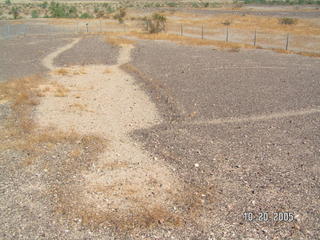
Intaglio n. (in TAL yo) a design or figure carved or engraved below the surface.
Our first knowledge of the existence of the Blythe Intaglios came from a list of area attractions at our campground in Ehrenberg, Arizona. We have been to see the pictographs at Seminole Canyon near Del Rio, Texas and the petroglyphs near Laughlin, Nevada, but we had never heard of intaglios. Geologist also refer to them as geoglyphs and they are of three known forms; one, where the design is created by aligning stones together to form a shape; two, where the intaglio is created by scraping rock and soil away to expose lighter soil underneath and three: by tramping into the earth thereby forming an indented impression or form.
The Blythe Intaglios were created by the scraping away of rock and gravel to expose the sandy soil. They were discovered in 1931 by a local pilot, George Palmer, who was flying over the area. The area is now managed by the Bureau of Land Management, which has put up a few small interpretive signs and has fenced the area around the intaglios. According to a couple of web sites, there are three sites and six figures, but in the main area there are two sites and four figures. The third site must be farther back on the trail but we didn't attempt it in our large truck as the main drive in is a very rough dirt and crushed stone road that has become rutted from wash outs.
There are two human figures and two animal figures at the two sites. The first site you arrive at has a human figure and a figure of a mountain lion (some non-Native Americans believe it to be a horse) and a serpent. The human figure is assumed to be a male as there is a phallus on the figure although that is difficult to see from ground level. This figure is 102 feet tall and the arm span is 64.9 feet wide. The arms on this figure have elbows and one leg is slightly bent. Original aerial photographs show a large circular path enclosing the upper half of the body but much of that has been destroyed before the figures were enclosed in a chain link fence.
The mountain lion/horse and serpent are very close to each other, perhaps signifying a battle or some religious meaning. Little is actually known about the age or meaning of these intaglios and local Native American oral history gives only a hint or possible meaning to their creation. The interpretive displays make no mention of what tribes existed locally nor any historical information about Native Americans in the area.
The next site is a single large figure is believed to be a figure of the Creator, according to local Native American oral history. The figure has its arms outstretched and original photographs showed fingers and toes and several lines extending from the head believed to be hair, but over time these were scuffed away. The arm span on the Creator is 91.8 feet wide and the length of the figure is 176 feet. The size of this intaglio in relation to the size of the first human figure is the reason it is assumed to be a figure depicting the “Creator”.
While there's not a lot of information about the site on site there are a couple of web sites that have aerial photographs that show the intaglios much better. I have to admit that we brought along a stepladder to take the photos show below as we had visited the site last year and wanted to try to get better shots than what we could get from ground level. I guess the BLM people figure that if they build viewing platforms someone would use it to climb into the enclosed areas.
No comments:
Post a Comment